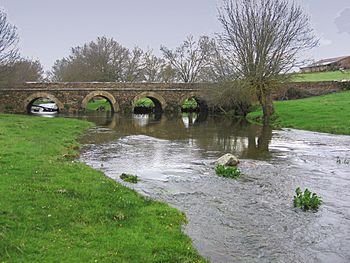Huebra facts for kids
Quick facts for kids Huebra |
|
|---|---|
 |
|
| Country | Spain |
| Physical characteristics | |
| Main source | Escurial de la Sierra and Hondura de Huebra |
| River mouth | Duero |
| Basin features | |
| Basin size | 2,881 square kilometres (1,112 sq mi) |
The Huebra River is a beautiful river in Spain. It starts its journey in the mountains near Escurial de la Sierra in the Salamanca province. From there, it flows through different landscapes before joining the much larger Duero River. The Huebra River is an important part of the natural environment in its region.
Contents
What is the Huebra River?
The Huebra is a natural waterway that collects water from a large area of land. This area is called its river basin. The river basin of the Huebra covers about 2,881 square kilometres (1,112 sq mi), which is a pretty big space! This means that all the rain and water that falls within this area eventually flows into the Huebra River.
Where Does the Huebra River Start?
The Huebra River begins high up in the mountains. Its main sources are found near two places: Escurial de la Sierra and Hondura de Huebra. These areas are in the Salamanca province of Spain. Imagine tiny streams forming from melting snow or rainfall, joining together to create a bigger stream, and then a river!
Where Does the Huebra River End?
After flowing for many kilometers, the Huebra River reaches its end. It flows into the Duero River. The Duero is one of the most important rivers in the Iberian Peninsula, which is the landmass where Spain and Portugal are located. So, the Huebra River is a tributary of the Duero, meaning it's a smaller river that flows into a larger one.
The Journey of the Huebra River
As the Huebra River travels, it passes through different towns and natural areas. It helps to shape the land around it, creating valleys and providing water for plants and animals. The river's path is not always straight; it winds and turns, creating a unique landscape.
Importance of the River
Rivers like the Huebra are very important for many reasons. They provide water for farming, which helps grow food. They also support many types of wildlife, including fish, birds, and other animals that live near the water. For people, rivers can be places for recreation, like fishing or simply enjoying nature.
See also
 In Spanish: Río Huebra para niños
In Spanish: Río Huebra para niños

